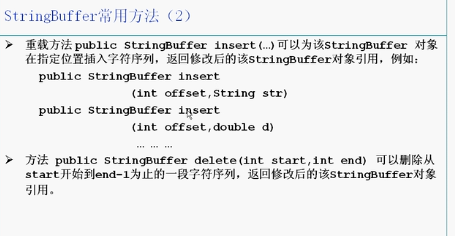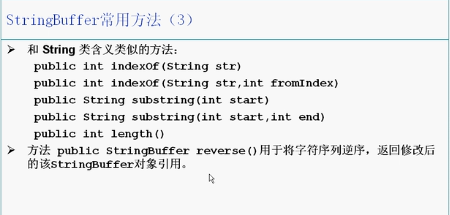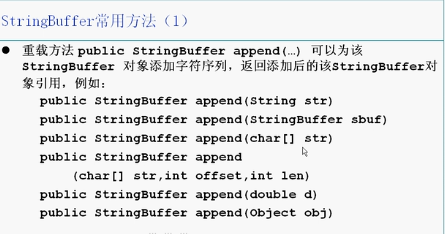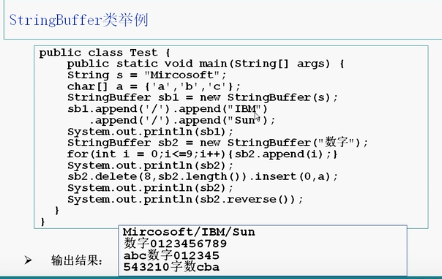


StringBuffer 方法
以下是 StringBuffer 类支持的主要方法:
| 序号 | 方法描述 |
|---|---|
| 1 | public StringBuffer append(String s) 将指定的字符串追加到此字符序列。 |
| 2 |
public StringBuffer reverse() 将此字符序列用其反转形式取代。 |
| 3 |
public delete(int start, int end) 移除此序列的子字符串中的字符。 |
| 4 |
public insert(int offset, int i) 将 int 参数的字符串表示形式插入此序列中。 |
| 5 |
replace(int start, int end, String str) 使用给定 String 中的字符替换此序列的子字符串中的字符。 |
下面的列表里的方法和 String 类的方法类似:
| 序号 | 方法描述 |
|---|---|
| 1 |
int capacity() 返回当前容量。 |
| 2 |
char charAt(int index) 返回此序列中指定索引处的 char 值。 |
| 3 |
void ensureCapacity(int minimumCapacity) 确保容量至少等于指定的最小值。 |
| 4 |
void getChars(int srcBegin, int srcEnd, char[] dst, int dstBegin) 将字符从此序列复制到目标字符数组 dst。 |
| 5 |
int indexOf(String str) 返回第一次出现的指定子字符串在该字符串中的索引。 |
| 6 |
int indexOf(String str, int fromIndex) 从指定的索引处开始,返回第一次出现的指定子字符串在该字符串中的索引。 |
| 7 |
int lastIndexOf(String str) 返回最右边出现的指定子字符串在此字符串中的索引。 |
| 8 |
int lastIndexOf(String str, int fromIndex) 返回 String 对象中子字符串最后出现的位置。 |
| 9 |
int length() 返回长度(字符数)。 |
| 10 |
void setCharAt(int index, char ch) 将给定索引处的字符设置为 ch。 |
| 11 |
void setLength(int newLength) 设置字符序列的长度。 |
| 12 |
CharSequence subSequence(int start, int end) 返回一个新的字符序列,该字符序列是此序列的子序列。 |
| 13 |
String substring(int start) 返回一个新的 String,它包含此字符序列当前所包含的字符子序列。 |
| 14 |
String substring(int start, int end) 返回一个新的 String,它包含此序列当前所包含的字符子序列。 |
| 15 |
String toString() 返回此序列中数据的字符串表示形式。 |

